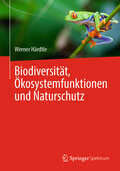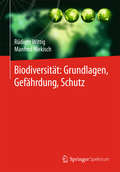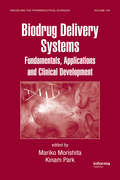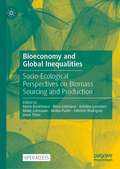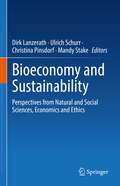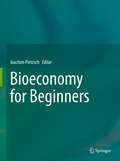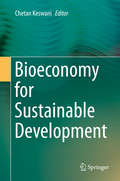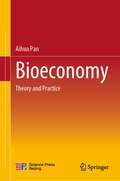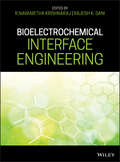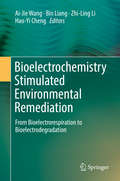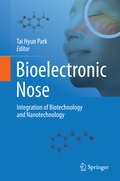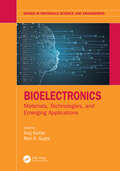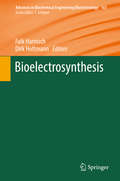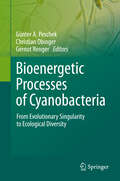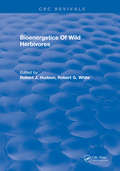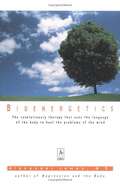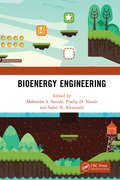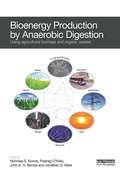- Table View
- List View
Biodiversität, Ökosystemfunktionen und Naturschutz
by Werner HärdtleDer weltweite Verlust an biologischer Vielfalt, verursacht durch eine nicht nachhaltige Nutzung von Ökosystemen, birgt schwerwiegende gesamtgesellschaftliche Risiken, welche jenen des Klimawandels vergleichbar sind. Doch erst seit wenigen Jahren verstehen wir genauer, warum biologische Vielfalt eine Grundvoraussetzung für die Stabilität und das Funktionieren von Ökosystemen und damit auch für gesellschaftlichen Wohlstand ist. Das vorliegende Buch stellt in anschaulicher und allgemeinverständlicher Form das heute verfügbare Wissen über die „funktionelle Bedeutung“ der globalen biologischen Vielfalt vor und erläutert anhand von faszinierenden und vielen wissenschaftlich neuen Beispielen, warum wir den Schutz der biologischen Vielfalt als dringende, gesamtgesellschaftliche Aufgabe begreifen müssen. Es erklärt, wie Pflanzen- und Tierarten miteinander zusammenleben und wie gerade ihre Wechselbeziehungen verschiedenste Ökosysteme – einem Uhrwerk vergleichbar – zum „funktionieren“ bringen oder diese gar gegenüber Störungen oder globalen Veränderungen stabilisieren. Anhand gut verständlicher und fesselnder Fallbeispiele zeigt das Buch, wie Artenvielfalt und diverse Lebensgemeinschaften unabdingbar sind für intakte Ökosysteme, und dass wir eine ungestörte Artenvielfalt schon deshalb benötigen, weil ohne sie die von uns Menschen zum Überleben notwendigen Serviceleistungen der Ökosysteme gar nicht zustande kämen.
Biodiversität: Grundlagen, Gefährdung, Schutz
by Rüdiger Wittig Manfred NiekischDer Botaniker Rüdiger Wittig und der Zoologe Manfred Niekisch geben einen breiten Überblick über die Diversität des Lebens auf der Erde. Sie zeigen nicht nur allgemein verständlich die wissenschaftlichen Grundlagen auf, sondern gehen ausführlich ein auf die materielle und spirituelle Bedeutung der Biodiversität für den Menschen und insbesondere auf die Umweltdienstleistungen, welche Ökosysteme erbringen. Ebenso dargestellt werden die Gründe der Gefährdung der Biodiversität sowie die Konventionen, rechtlichen Instrumente und praktischen Möglichkeiten, welche für den Schutz von Tieren, Pflanzen und Ökosystemen zur Verfügung stehen. Beleuchtet wird auch die Rolle der Nichtregierungsorganisationen.
Biodrug Delivery Systems: Fundamentals, Applications and Clinical Development (Drugs and the Pharmaceutical Sciences)
by Kinam Park Mariko MorishitaBiodrug Delivery Systems: Fundamentals, Applications and Clinical Development presents the work of an international group of leading experts in drug development and biopharmaceutical science who discuss the latest advances in biodrug delivery systems and associated techniques. The book discusses components of successful formulation, delivery, and p
Bioeconomy and Global Inequalities: Socio-Ecological Perspectives on Biomass Sourcing and Production
by Rosa Lehmann Anne Tittor Maria Backhouse Kristina Lorenzen Malte Lühmann Janina Puder Fabricio RodríguezThis open access book focuses on the meanings, agendas, as well as the local and global implications of bioeconomy and bioenergy policies in and across South America, Asia and Europe. It explores how a transition away from a fossil and towards a bio-based economic order alters, reinforces and challenges socio-ecological inequalities. The volume presents a historically informed and empirically rich discussion of bioeconomy developments with a particular focus on bio-based energy. A series of conceptual discussions and case studies with a multidisciplinary background in the social sciences illuminate how the deployment of biomass sources from the agricultural and forestry sectors affect societal changes concerning knowledge production, land and labour relations, political participation and international trade. How can a global perspective on socio-ecological inequalities contribute to a complex and critical understanding of bioeconomy? Who participates in the negotiation of specific bioeconomy policies and who does not? Who determines the agenda? To what extent does the bioeconomy affect existing socio-ecological inequalities in rural areas? What are the implications of the bioeconomy for existing relations of extraction and inequalities across regions? The volume is an invitation to reflect upon these questions and more, at a time when the need for an ecological and socially just transition away from a carbon intensive economy is becoming increasingly pressing.
Bioeconomy and Sustainability: Perspectives from Natural and Social Sciences, Economics and Ethics
by Ulrich Schurr Dirk Lanzerath Christina Pinsdorf Mandy StakeIn this edited volume, scientists from different disciplines discuss modern biotechnological processes and a knowledge-based bioeconomy. The authors base their arguments on ecological, economic, legal, social and ethical aspects. Moreover, they explore the opportunities, risks, and challenges of bioeconomic concepts and biotechnologies in many subject areas. The chapters consider land use, nature and environment, nutrition, technology and governance, energy, economy, law and regulation, as well as ethics. A special focus should be on new technologies and how they can be used, without compromising the ambitious goal of creating a more sustainable, but also fair world. To do justice to this broad array of topics, the editors frame all topics in overarching introductions and close the volume with final conclusions. Thereby this volume offers data and critical thoughts for any member of a Bioeconomy – be it from academia, the industry or public regulation.
Bioeconomy for Beginners
by Stephan Meyer Wolfgang Zettlmeier Ulrich SchurrThis book provides an interdisciplinary and comprehensible introduction to bioeconomy. It thus provides basic knowledge for understanding a transformation process that will shape the 21st century and requires the integration of many disciplines and industries that have had little to do with each other up to now. We are talking about the gradual and necessary transition from the age of fossil fuels, which began around 200 years ago, to a global economy based on renewable raw materials (and renewable energies). The success of this transition is key to coping with the challenge of climate change. This book conceives the realization of bioeconomy as a threefold task – a scientific, an economic and an ecological one. · Where does the biomass come from that we need primarily for feeding the growing world population but also for future energy and material use? How can it be processed in biorefineries and what role does biotechnology play in this regard? · Which aspects of innovation economics need to be considered, which economic aspects of value creation, competitiveness and customer acceptance are important? · What conditions must a bioeconomy fulfil in order to enable a sustainable development of life on earth? May it be regarded as a key to further economic growth or shouldn’t it rather orient itself towards the ideal of sufficiency? By dealing with these questions from the not necessarily consistent perspectives of proven experts, this book provides an interdisciplinary overview of a dynamic field of research and practice that raises more questions than answers and thus may nurture the motivation of many more people to seriously engage for the realization of a bioeconomy.
Bioeconomy for Sustainable Development
by Chetan KeswaniThe current era of incredible innovations has made science and technology one of the most powerful tools to meet the goals of incremental prosperity for humans and sustainable development. The development of the biotech industry in any given country is shaped by the characteristics of the technology—particularly its close relation to scientific knowledge—and by country-specific factors—the level and nature of the scientific knowledge base, the institutional set-up, and the role assumed by the government—which influence the country's ability to exploit new opportunities and appropriate the respective results.This book presents an integrated approach for sustained innovation in various areas of biotechnology. Focusing mainly on the industrial, socio-economic and legal implications of biotechnological advances, it examines in detail not only the implications of IPR in omics-based research but also the ethical and intellectual standards and how these can be developed for sustained innovation.Integrating science and business, it offers a peek behind the scenes of the biotech industry and provides a comprehensive analysis of the foundations of the present day industry for students and professionals alike. The book is divided into three parts: Food and Agricultural BiotechnologyIndustrial BiotechnologyPharmaceutical Biotechnology
Bioeconomy of Streptomyces
by Kashyap Kumar Dubey Punit KumarThis book provides a comprehensive understanding of streptomycetes, highlighting their various habitats, diversity, genetic structure, and metabolic engineering techniques to enhance the production of secondary metabolites. It also presents techniques for the isolation, cultivation, biochemical identification, chemotaxonomy, and phylogenetic analysis of streptomycetes. The book explores the production of bioactive compounds from streptomycetes, including novel natural products, antimicrobial agents, pharmaceuticals, medicinal compounds, and bioactive enzymes. Furthermore, the book examines the diverse applications of streptomycetes in agriculture, medicine, industry, and bioremediation. The chapters emphasize the latest technological advancements such as bioprocess optimization, genetic engineering, metabolic engineering, genome mining, and pathway engineering for enhancing the production of secondary metabolites from Streptomyces. As such, this book is of interest to academicians, researchers, and professionals working in the fields of bioprocessing, microbiology, industrial microbiology, medical microbiology, fermentation technology, and biotechnology.
Bioeconomy: Theory and Practice
by Aihua PanThis book focuses on the new concept of bioeconomy which collects the wisdom from life science, medicine and economics. lt finds the origins from ten existing theories, and also regards as “Pan's bioeconomy”. It has provided new methods for economic science research, opened up new fields for life science research, provided the right answer for China's economic miracle, filled the gap between materialism and idealism, and removed the fence between natural science and social science
Bioelectrochemical Interface Engineering
by Rajesh K. Sani R. Navanietha KrishnarajAn introduction to the fundamental concepts and rules in bioelectrochemistry and explores latest advancements in the field Bioelectrochemical Interface Engineering offers a guide to this burgeoning interdisciplinary field. The authors—noted experts on the topic—present a detailed explanation of the field’s basic concepts, provide a fundamental understanding of the principle of electrocatalysis, electrochemical activity of the electroactive microorganisms, and mechanisms of electron transfer at electrode-electrolyte interfaces. They also explore the design and development of bioelectrochemical systems. The authors review recent advances in the field including: the development of new bioelectrochemical configurations, new electrode materials, electrode functionalization strategies, and extremophilic electroactive microorganisms. These current developments hold the promise of powering the systems in remote locations such as deep sea and extra-terrestrial space as well as powering implantable energy devices and controlled drug delivery. This important book: • Explores the fundamental concepts and rules in bioelectrochemistry and details the latest advancements • Presents principles of electrocatalysis, electroactive microorganisms, types and mechanisms of electron transfer at electrode-electrolyte interfaces, electron transfer kinetics in bioelectrocatalysis, and more • Covers microbial electrochemical systems and discusses bioelectrosynthesis and biosensors, and bioelectrochemical wastewater treatment • Reviews microbial biosensor, microfluidic and lab-on-chip devices, flexible electronics, and paper and stretchable electrodes Written for researchers, technicians, and students in chemistry, biology, energy and environmental science, Bioelectrochemical Interface Engineering provides a strong foundation to this advanced field by presenting the core concepts, basic principles, and newest advances.
Bioelectrochemistry Stimulated Environmental Remediation: From Bioelectrorespiration to Bioelectrodegradation
by Bin Liang Ai-Jie Wang Zhi-Ling Li Hao-Yi ChengThis book reviews the latest advances in the bioelectrochemical degradation of recalcitrant environmental contaminants. The first part introduces readers to the basic principles and methodologies of bioelectrochemical systems, electron-respiring microorganisms, the electron transfer mechanism and functional electrode materials. In turn, the second part addresses the bioelectrochemical remediation/treatment of various environmental pollutants (including highly toxic refractory organics, heavy metals, and nitrates) in wastewater, sediment and wetlands. Reactor configuration optimization, hybrid technology amplification and enhanced removal principles and techniques are also discussed.The book offers a valuable resource for all researchers and professionals working in environmental science and engineering, bioelectrochemistry, environmental microbiology and biotechnology.
Bioelectrochemistry of Biomembranes and Biomimetic Membranes
by Rolando GuidelliInvaluable to biochemists, biophysicists, and pharmacological scientists; this book provides insights into the essential principles required to understand why and how electrochemical and electrophysiological tools are fundamental in elucidating the mode of ion transport across biomembranes.* Describes the essential electrochemical basics required to understand why and how electrochemical and electrophysiological tools are fundamental in elucidating the mode of ion transport across biomembranes* Requires only basic physical chemistry and mathematics to be understood, without intermediate stumbling blocks that would discourage the reader from proceeding further* Develops contents in a step-by-step approach that encourages students and researchers to read from beginning to end
Bioelectromagnetic and Subtle Energy Medicine
by Davis LangdonBioelectromagnetic and Subtle Energy Medicine focuses on a wide variety of evidence-based bioelectromagnetic and subtle energy therapies for disorders ranging from cancer, cardiomyopathy, and Parkinson's disease to depression, anxiety, and pain. Since publication of the first edition more than a decade ago, there have been so many advances in these
Bioelectromagnetism: History, Foundations and Applications
by Shoogo UenoBioelectromagnetism has been gradually developing and expanding into a variety of fields in engineering, biomedical engineering, life science, medicine and biology. Bioelectromagnetism: History, Foundations and Applications provides an overview of the field and its developments; from its inception and growth through the twenty-first century, to the latest advances in electro- and magnetobiology and hazard evaluations of electromagnetic fields.It is organized into three sections, each focusing on specific regions of bioelectromagnetism. It begins with the foundations of the field and its history, with a chronological treatment of the major subjects in bioelectromagnetism. The relationship between atmospheric electromagnetic phenomena, geomagnetism and biological systems are presented. It then discusses the many benefits of bioelectromagnetism: electroreception, magnetic navigation, magnetic sense and magnetic responses of plants, birds, animals and humans. It then moves on to human health issues and the impact of bioelectromagnetism. It also provides practical guidance on how to set safety guidelines. Finally, it looks forward to the future prospects of the field based on the latest research in the field.In exploring both the history of the field and the latest developments in today’s research advances, this book provides a comprehensive and self-contained treatment on the subject, which will be a valuable reference for researchers in biophysics, medicine, electrical engineering and biomedical engineering.It can be used as a companion to the editor’s previously published books: Biomagnetics: Principles and Applications of Biomagnetic Stimulation and Imaging (9781482239201, 2016, CRC Press); and Bioimaging: Imaging by Light and Electromagnetics in Medicine and Biology (9780367203047, 2020, CRC Press).Key Features: Provides both a historical view of the field, along with the latest developments in the field Contains practical guidance for researchers on how to set safety guidelines for those working in the area Edited by authorities in the field, with chapter contributions from specialists
Bioelectronic Nose: Integration of Biotechnology and Nanotechnology
by Tai Hyun ParkThe "bioelectronic nose", the device which has a similar function to the human smell sensing system, can be realized by combining the olfactory cells or receptors with nanotechnology. In the last two decades, much has been learned about the smell sensing mechanism in biological systems. With knowledge about the biological olfactory system and the techniques for the expression of biological receptor proteins, we are able to utilize biological materials and systems to mimic the biological olfactory system. In addition to the advances in biological and biotechnological area, nanotechnology has progressed to a great degree. The bioelectronic nose is a good example of the integration of biotechnology and nanotechnology. This book describes basic biological sciences of the olfactory system, biotechnology for the production of olfactory biological elements, and nanotechnology for the development of various sensing devices. The purpose of this book is to provide the reader with a concept, basic sciences, fundamental technologies, applications, and perspectives of the bioelectronic nose.
Bioelectronics: Materials, Technologies, and Emerging Applications (Series in Materials Science and Engineering)
by Anuj Kumar Ram K. GuptaBioelectronics is emerging as a new area of research where electronics can selectively detect, record, and monitor physiological signals. This is a rapidly expanding area of medical research, that relies heavily on multidisciplinary technology development and cutting-edge research in chemical, biological, engineering, and physical science. This book provides extensive information on the (i) fundamental concepts of bioelectronics, (ii) materials for the developments of bioelectronics such as implantable electronics, self-powered devices, bioelectronic sensors, flexible bioelectronics, etc, and (iii) an overview of the trends and gathering of the latest bioelectronic progress. This book will broaden our knowledge about newer technologies and processes used in bioelectronics.
Bioelectrosynthesis (Advances in Biochemical Engineering/Biotechnology #167)
by Falk Harnisch Dirk HoltmannThis volume discusses both the latest experimental research in bioelectrosynthesis and current applications. Beginning with an introduction into the “electrification of biotechnology” as well as the underlying fundamentals, the volume then discusses a wide range of topics based on the interfacing of biotechnological and electrochemical reaction steps. It includes contributions on the different aspects of bioelectrochemical applications for synthesis purposes, i.e. the production of fine and platform chemicals based on enzymatically or microbially catalyzed reactions driven by electric energy. The volume finishes with a summary and outlook chapter which gives an overview of the current status of the field and future perspectives. Edited by experts in the field, and authored by a wide range of international researchers, this volume assesses how research from today’s lab bench can be developed into industrial applications, and is of interest to researchers in academia and industry.
Bioenergetic Processes of Cyanobacteria: From Evolutionary Singularity to Ecological Diversity
by Christian Obinger Gernot Renger Guenter A. PeschekThis publication is unique among a number of books on cyanobacteria because it focuses on the bioenergetics of these widespread organisms which are the evolutionary prerequisite for the development of all higher forms of life on our "blue" planet. The book primarily addresses questions of energy conversion by the fundamental bioenergetic processes: (oxygenic) photosynthesis, (aerobic) respiration, and (anaerobic) fermentation which uniquely occur together in these prokaryotic cells. Thermophilic cyanobacteria offer the most suitable material for high resolution structure analyses of Photosystem I and II and other electron transport complexes by X-ray crystallography (for example, at present the structure of Photosystem II at atomic resolution is only known for these organisms). These achievements during the last decade represent a milestone in our understanding of the complexes which are crucial for solar energy exploitation through photosynthetic water splitting. The present work represents an ambitious attempt to achieve the goal of a synoptic state-of-the-art picture by casting together the mosaics of detailed knowledge described by leading experts in the field. It contains 24 chapters written by 35 authors from Europe, USA, India and Japan. The book is aimed at reaching a broad audience ranging from students to experienced scientists. The editors wish all readers a pleasant and stimulating journey through the fascinating "world" of the bioenergetics of cyanobacteria and sincerely hope that this book will not only be of great value for the experts but also entice young people into this exciting research area with the aim to address successfully the challenging problems of high relevance that are still waiting for a satisfactory answer.
Bioenergetics Of Wild Herbivores
by Robert J. HudsonBioenergetics is an emerging discipline which offers a more profound understanding of the ecology, behaviour, and evolution of wild herbivores. Increasingly, bioenergetic principles have been applied in management since they provide insight into population dynamics and are relevant to manipulation of habitats and assessment of the impacts of resource development. Growing interest in the agricultural potential of wild herbivores has provided further impetus. In spite of this promise, there are few comprehensive syntheses of the concept and its application to wild herbivores. This volume attempts to fill this need. This book provides a great amount of detail but its expressive aim is to lead us to the whole animal, to a herd, to population as integral parts of an ecological entity which in turn is the result of evolutionary forces.The concept of this book promises the realization of an overdue change in the approach to bioenergetics, to nutrition and husbandry, and thus to the management of wild herbivores: the final emancipation from rules and views based primarily on domesticated herbivores or on experimental animals held under unnatural conditions, necessarily impending them behaviourally, physically, and psychically.
Bioenergetics: A Bridge across Life and Universe
by Davor JureticBioenergetics deals with the very first energy transformation steps performed by living cells. Increased dissipation is the primary effect of processing external energy packages. Enzyme-supported charge separation is the minor but essential outcome for maintaining life. This book explores the usefulness of dissecting the entropy production of enzymes involved in cellular defenses, fermentation, respiration, and photosynthesis, assuming that tightly regulated dissipation is the hallmark of life. Researchers, educators, and students of life sciences can find in this text many examples of how we can use the interdisciplinary approach to study cells' virtuoso ability to connect the microscopic to the macroscopic world. Each chapter is a self-contained unit with a glossary and selected references for further reading.
Bioenergetics: The Revolutionary Therapy That Uses The Language Of The Body To Heal The Problems Of The Mind (Compass Ser.)
by Alexander LowenBioenergetics is the revolutionary new therapy that uses the language of the body to heal the problems of the mind. This exciting body-mind approach to personality has a liberating and positive effect on emotional, physical, and psychic distress. Dr. Alexander Lowen, founder and prime mover of this fast-growing therapy, writes that increased joy and pleasure are possible in every day life through an understanding of how your body functions energetically: how it determines what you feel, think, and do. Dr. Lowen points out that lack of energy is the result of chronic muscular tensions, a condition caused by the suppression of feelings. <P><P>These tensions can be dissolved through the direct body work in bioenergetic exercise, which restores the potential for living a rich, full life. Dr. Lowen analyzes common physical ailments like headaches and lower back pain and shows how they too can be overcome by releasing the muscular tenstion that create them. Generously illustrated with line drawings of bioenergetic exercises, this book is sure to bring freedom, confidence, and pleasure to thousands of men and women. <P><P>"In this highly interesting and valuable attempt to restore the body to the mind, Dr. Alexander Lowen sets out in a practically useful way the principles of his new form of psychotherapy. Bioenergetics is destined to become widely influential."
Bioenergy Crops: A Sustainable Means of Phytoremediation
by Jos T. PuthurBioenergy Crops: A Sustainable Means of Phytoremediation comprises a unique combination of topics related to the field of phytoremediation and bioenergy production. It highlights the future face of industries in phytoremediation and bioenergy production. The book deals with most promising plant and alga species for biomass production and phytoremediation. It deals with constructed wetlands, bioremediation and microbial fuel cells with case studies of phytoremediation and bioenergy production. The comprehensive knowledge on the dual aspects of hyperaccumulators in phytoremediation and bioenergy production guides graduates, post-graduates as well as researchers to know the latest updates in the field. Key Features:• Presents dual aspects of hyperaccumulators in phytoremediation and bioenergy production.• Highlights the future face of industries in phytoremediation and bioenergy production.• Focuses the promising candidates exploits as hyperaccumulator and biomass producers.• Explains the role of algae and microbes in bioremediation and bioenergy production.• Represents a comprehensive, up-to-date analysis in the field of phytoremediation as well as bioenergy production.
Bioenergy Development: Issues and Impacts for Poverty and Natural Resource Management
by Gerhard Dieterle Elizabeth Cushion Adrian WhitemanBioenergy has been critically important since our ancestors first used wood to cook their food and stay warm at night. Traditional forms of bioenergy, firewood and cow dung patties, remain primary fuel sources for many rural and poor people. More modern sources of bioenergy--including ethanol and biodiesel for transport and wood pellets for heating, among many others--offer great promise but generate great controversy. This book gives an overview of bioenergy developments. It examines the main issues and possible socioeconomic implications of these developments, as well as their potential impacts on land use and the environment, especially with respect to forests. The authors present an introduction to bioenergy, provide a background and overview of solid biomass and liquid biofuels, and examine the opportunities and challenges at the regional and country levels. They also examine potential impacts for specific types of bioenergy. 'Bioenergy Development' does not attempt to be definitive on such subjects as the impact of bioenergy on food prices, but it does suggest the tradeoffs that need to be examined when considering bioenergy policies. The authors offer five main findings: Solid biomass will continue to provide a principal source of energy and should not be overlooked. There will be major land-use implications resulting from bioenergy developments. It is critical to consider tradeoffs-including those related to poverty, equity, and the environment-when considering bioenergy policies. There is considerable potential for an increased use of forestry and timber waste as a bioenergy feedstock. The climate change impacts of bioenergy development are uncertain, and highly specific to location and feedstock.
Bioenergy Engineering
by Mahendra S. Seveda; Pradip D. Narale; Sudhir N. KharpudeThe book provides information on recent advancements in bioenergy engineering to graduates, post-graduates, research scholars, faculty members, academician, researchers and practitioners studying and working in field of the bioenergy engineering. It is an invaluable information resource on biomass-based biofuels for fundamental and applied research, catering to researchers in the areas of biogas technology, densification techniques, biomass gasification, torrefaction of biomass, biochar production, micro algae production, improved biomass cookstoves, bio-ethanol production and the use of microbial processes in the conversion of biomass into biofuels. It will also be useful to faculties and researchers to understand the present status, advancements and policies in implementation of bioenergy technologies in India. This book will definitely provide a direction to the young researchers in identification of thrust areas of research in the field of bioenergy. The book concludes with research and development endeavours and aspects relating to implementation of advance bioenergy technologies.
Bioenergy Production by Anaerobic Digestion: Using Agricultural Biomass and Organic Wastes (Routledge Studies in Bioenergy)
by Nicholas E. Korres Padraig O'Kiely John A.H. Benzie Jonathan S. WestInterest in anaerobic digestion (AD), the process of energy production through the production of biogas, has increased rapidly in recent years. Agricultural and other organic waste are important substrates that can be treated by AD. This book is one of the first to provide a broad introduction to anaerobic digestion and its potential to turn agricultural crops or crop residues, animal and other organic waste, into biomethane. The substrates used can include any non-woody materials, including grass and maize silage, seaweeds, municipal and industrial wastes. These are all systematically reviewed in terms of their suitability from a biological, technical and economic perspective. In the past the technical competence and high capital investment required for industrial-scale anaerobic digesters has limited their uptake, but the authors show that recent advances have made smaller-scale systems more viable through a greater understanding of optimising bacterial metabolism and productivity. Broader issues such as life cycle assessment and energy policies to promote AD are also discussed.
